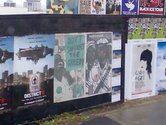John Hurrell – 25 August, 2009
Most of the time the printed faces and figures look like they are from the sixties, having the flattened heavy contours that you get with a lot of, say, Beatles or Haight-Ashbury posters
Auckland
Emory Douglas
Minister of Culture, Black Panther Party
21 August - 3 October 2009
One of the more unusual exhibitions for a university gallery, this show is part of the Elam International Artist in Residence programme currently hosting the Black PantherParty’s Minister of Culture, Emory Douglas. Douglas is a graphic artist who in the sixties and seventies, when designing posters and literature for his local Oakland black community, also helped educate a hostile white audience, and later influence poster-design in Cuba and other countries. He is considered an important global propagandist for early Black Pride.
In an art gallery or museum setting like the Gus Fisher these works often look unsubtle and crude. However it must be remembered they were made during a state of war with the American police and American government, and so were primarily created for community newspapers, poster walls and flyers. Their message of counteracting racial hatred and poverty, and of raising self-esteem, needed to be understood quickly - and be an effective method of winning support.
In the small Gus Fisher exhibiting space Douglas’ muted coloured newspaper images look impressive as a total arrangement. One wall has a single huge glued-up work that is a hybrid of several other smaller posters; another has 12 printed mounted pages (image with text, often with smaller min-images inserted within badges or spectacle lenses); and a third has 5 big posters (each 9 times the size of a standard page). Most of the time the printed faces and figures look like they are from the sixties, having the flattened heavy contours that you get with a lot of, say, Beatles or Haight-Ashbury posters. A few look as though they come from fifties book illustration by Social Realist artists like Ben Shahn.
Many images have radiating sun-beams as backdrops, a reference perhaps to Russian Communist images of farm labourers toiling out in the open fields. Often Douglas has taken images of singing women from books on negro spirituals and combined them with hard-hitting texts from political theorists or sayings from Panther leaders like Huey Newton, Bobby Searle or Eldridge Cleaver. On other occasions his images pour scorn on the police as murderous ‘pigs’, attack poisonous pesticides, greedy slum landlords, or American foreign policy - ideas which though radical forty years ago are commonplace now.
If the show has a weakness it is that it doesn’t tell us enough about Douglas’ pre-Panther art training, and how he acquired his graphic skills. It also doesn’t provide a twentieth century art historical context, comparing him with other related activist artists, like Heartfield or Grosz for example. A fascinating (inspiring and disturbing) time capsule nonetheless.




 Advertising in this column
Advertising in this column Two Rooms presents a program of residencies and projects
Two Rooms presents a program of residencies and projects



This Discussion has 0 comments.
Comment
Participate
Register to Participate.
Sign in
Sign in to an existing account.